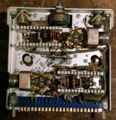4S1
The Tektronix Type 4S1 is a dual-trace sampling unit for the 661. Each channel has a trigger pickoff, a delay line, and a sampler. Specified rise time is 350ps. The sampling pulses for each channel are generated by a step recovery diode are are fed to a sampling bridge made with of four GaAs diodes. These diodes are fragile and exact replacements are hard to find. People have improvised replacements using modern integrated Schottky diodes such as those in HP/Agilent's HSMS-28x series. The 4S1 has a dual-trace mode, where the A waveform and the B waveform are both displayed in the time domain at the same time with a single trigger source and a single equivalent-time sweep rate. Another mode is called "A vert/B horiz". This mode is used in conjunction with an X-Y mode switch on the panel of the 661. The signals enter the 4S1 through GR-874 connectors on the front panel.
The 4S1 uses an unusual trigger amplifier with two trigger signal paths. One path is for low frequencies, the other for high frequencies. (A similar approach was also used in the main vertical signal path of the 7A29 several years later.) From serial number 101 to 1349, the low frequency path starts with a 25K resistor that DC-couples the input signal to a 2N1429 PNP emitter-follower stage. After that is an 151-103 NPN common-emitter. The high frequency path starts with a trigger pickoff transformer on the input. The pickoff signal feeds a common-base amplifier that uses a 2N700 PNP transistor. The low frequency and high frequency trigger paths meet at the trigger output of the 4S1. From there, the trigger signal passes through the 661, and into a 5T1 or 5T3. 4S1 units with serial number 1350 and up use a slightly less complex trigger amplifier circuit. The later circuit uses a TA2333 silicon NPN transistor to amplify the entire frequency range.
-
top view of 4S1
-
Coaxial interconnect from timing plug-in goes through the mainframe, into the 4S1, and ends here, at the sampler.
-
This is the sampler. The GaAs sampling diodes are arranged in a diamond shape and are directly connected to the socket from the delay line.
-
The delay line is a coil of coax going from the trigger pickoff to the sampler.



